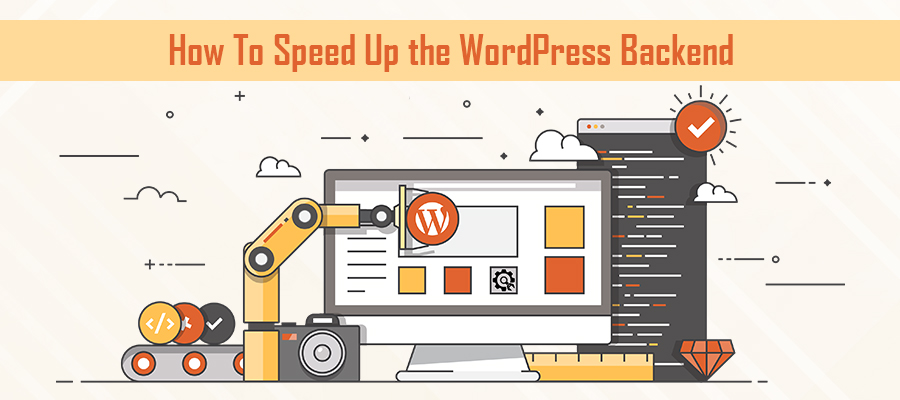 When you think of a slow WordPress site, it’s common to automatically image dreadfully long page load times. While the majority of effort and concentration is focused on boosting on-page response times, frontend performance isn’t the only area of your WordPress site capable of moving at the speed of sloth.
When you think of a slow WordPress site, it’s common to automatically image dreadfully long page load times. While the majority of effort and concentration is focused on boosting on-page response times, frontend performance isn’t the only area of your WordPress site capable of moving at the speed of sloth.
Slow WordPress admin areas, also known as the WordPress backend, is generally not even a concept until it happens. For many novice WordPress users, the notion of a sluggish admin dashboard wasn’t even a possibility. That is, until switching pages or updating a plugin goes from fast to painfully slow.
Even though a slow WordPress admin area may not translate to slow frontend response times, this situation isn’t just annoying. For many WordPress users, underperforming dashboards translates into significant loss in productivity. If you’ve ever found yourself operating a WordPress dashboard that’s as fast as a snail, then you fully comprehend how detrimental this situation actually is.
In the most serious of cases, a slow WordPress admin dashboard can actually result in a complete shutdown. This is to say, if pages take too long to load, your entire admin area may stop loading at all.
Your WordPress admin panel is the heart of your site. If you’re currently facing a drop in its efficiency, response time or overall functionality, it’s time to get serious. Failure to immediately correct this situation is almost guaranteeing a more serious, and time-consuming, problem down the road.
Step #1 – Upgrade Web Server RAM
While this may seem a bit extreme, more times than not, a sluggish WordPress admin dashboard is a direct result of unsatisfactory server RAM. If you’re a novice when it comes to web server resource allocation and configuration, the best move is contacting your hosting provider.
Upon doing so, inquire about your specific RAM allocation and current/historical usage. They should be able to tell you if you’re near or exceeding current limits. Should you be unable to increase RAM on your current hosting plan, you may need to consider the very real possibility of upgrading to a more advanced hosting provider and/or plan.
For example, WordPress sites are increasingly becoming more advanced. While this translates to greater user engagement and unprecedented opportunities for growth, it also means traditional solutions are less likely to satisfy website requirements. If this sounds like your situation, seriously consider moving to a virtual web server. The most affordable option, and easiest in terms of transitioning, is a cloud-based server.
Generally, these solutions offer exponentially more powerful technologies, virtually limitless resources and pricing options that are comparative to traditional shared server hosting plans.
Step #2 – Investigate Plugins for High CPU Demand
We’ve all been there. You finally have a WordPress site and the world of limitless possibilities supported by plugins is almost euphoric.
In a mad dash, you install and activate countless plugins and enjoy the unique virtual world you’ve created. Unfortunately, the ease of installation and use has mislead countless WordPress users to believe plugins aren’t capable of harming backend (or frontend) performance.
While a good portion of plugins are specifically designed to not bog your server CPU, or in a more generalized term “resources,” some plugins are notoriously demanding.
The most common plugin types responsible for WordPress admin dashboard slowdowns perform one of the following actions:
- Related Post
- Website Statistic Reports
- Chat/Messaging
- Page Builders
- Calendar/Event Management
- Sitemap
- Any Ongoing Scan/Continuous Process Plugin
Aren’t sure how your plugins are influencing server CPU performance? Try running P3 Plugin and review the runtime chart. This highlights individual plugins that are consistently running, which is a common sign that it’s negatively influencing the WordPress backend.
Deactivate any plugin with a long runtime report and see if your admin panel begins to respond as normal.
Step #3 – Verify Web Server Performance
While web server issues, such as sluggish response time, is historically marked as being responsible for frontend slowdowns, it can also affect the WordPress backend.
The easiest way to determine if this is the cause is by running your site through a server speed testing tool. While there are many options available, the HTTP/HTTPS Web Server Test by Dotcom-Tools offers a complete breakdown of server response time, page load time and other essential metrics.
Step #4 – Update to Latest Version of PHP
Much of the functionality of WordPress is leveraged with PHP scripting. Unlike other backend codes, this version typically isn’t automatically upgraded by your web host.
As of 2018, PHP 7 is the latest stable version supported by WordPress. Along with enhanced site security, PHP 7 significantly boosts site performance, which includes your admin dashboard panel.
Before upgrading to PHP 7, confirm your WordPress plugins and themes are compatible. It’s important to note that not all web hosting providers offer/support PHP 7.
Step #5 – Disable Unnecessary WordPress Settings
One of the biggest issues plaguing WordPress is its automatic use of settings many users deem unnecessary.
While most of these aren’t obviously known, some are responsible for soaking up CPU power and slowing down your WordPress backend. This is especially true if your site already features CPU-demanding plugins and elements.
The easiest way to eliminate these performance-draining components is by downloading and activating the WP Disable plugin.
Once activated, simply deactivate every setting you don’t currently use or will never require. This is often the quickest say to restore WordPress backend speed and functionality to its original glory.


